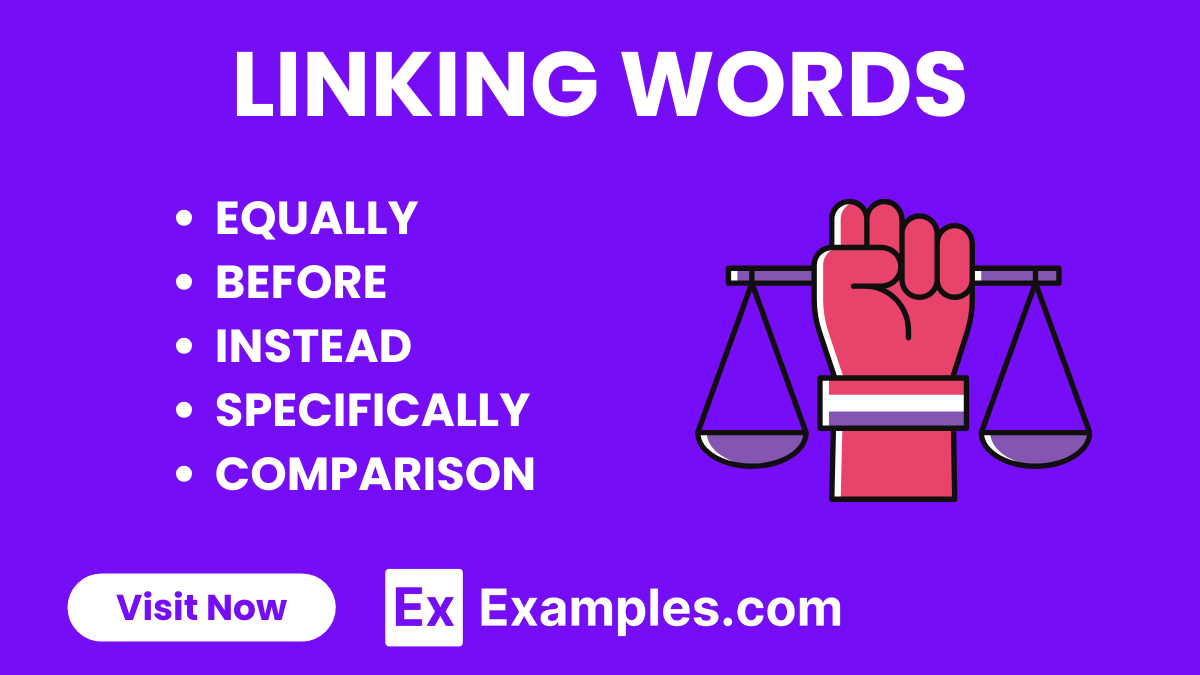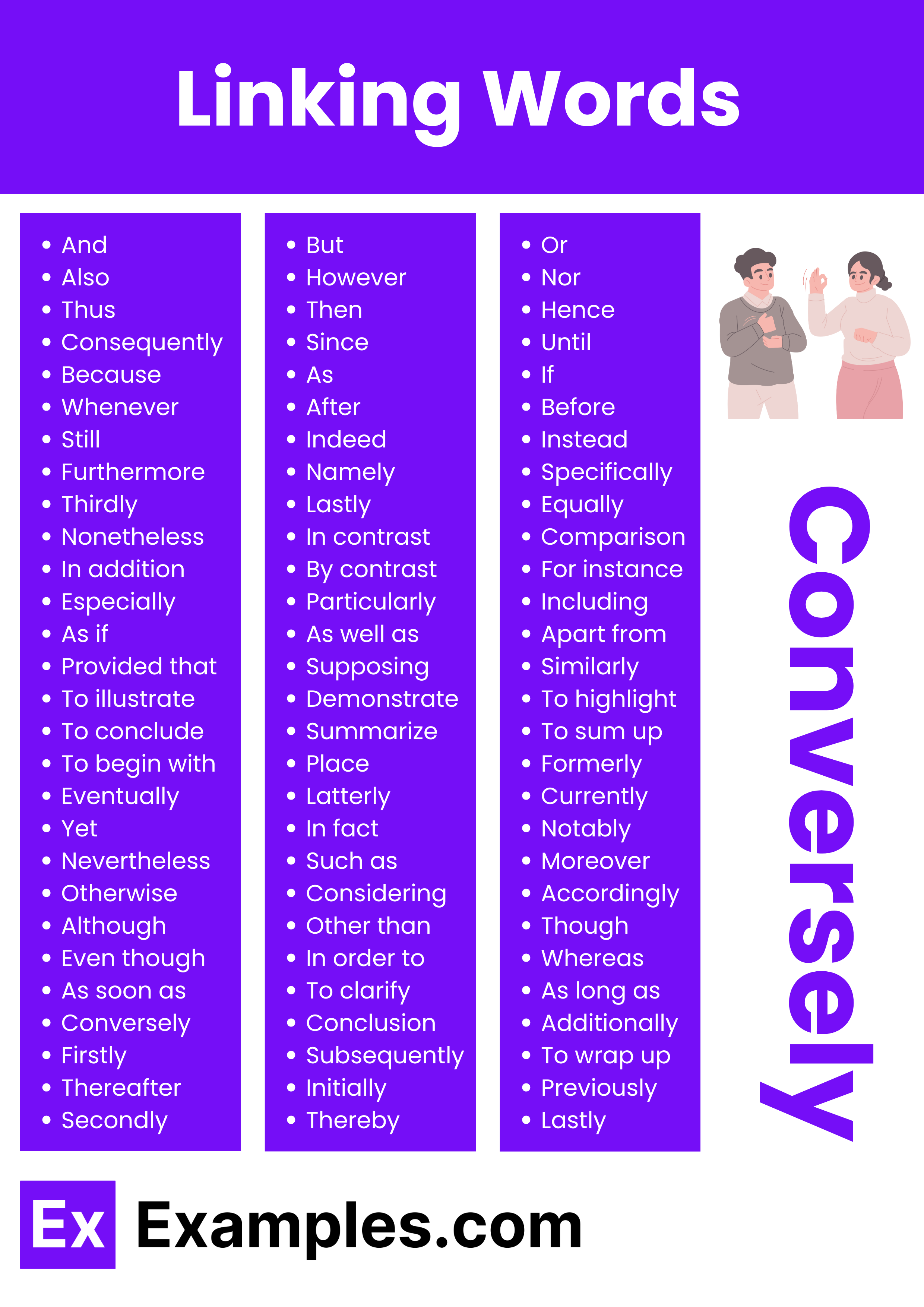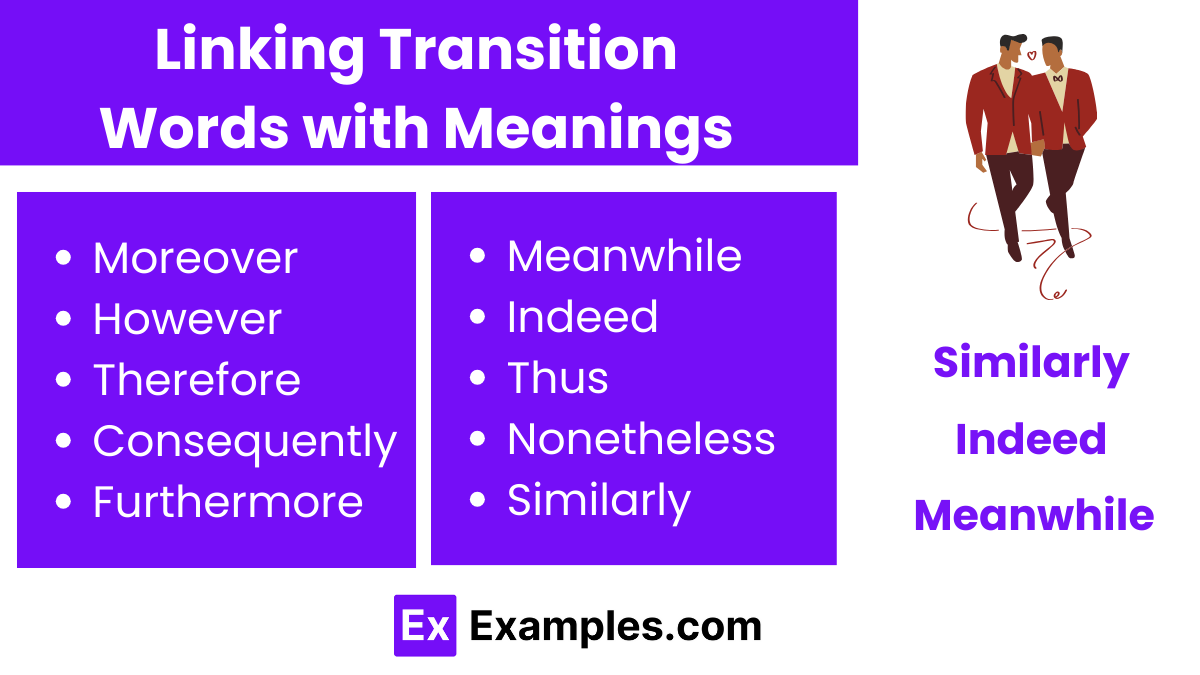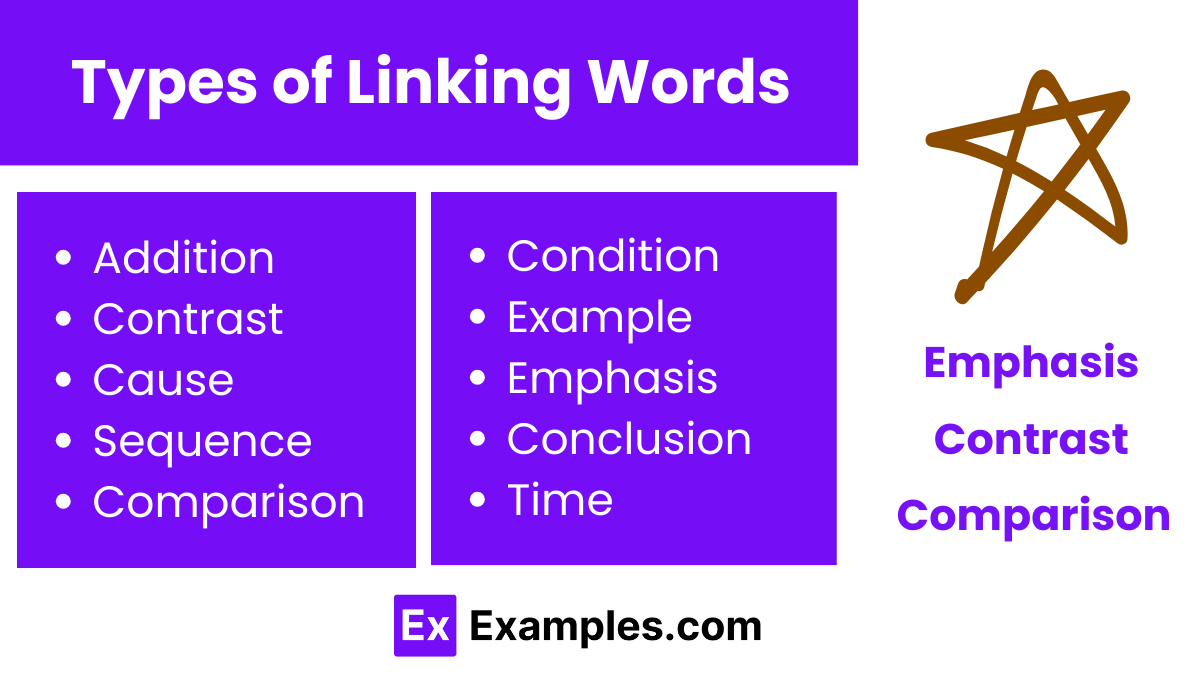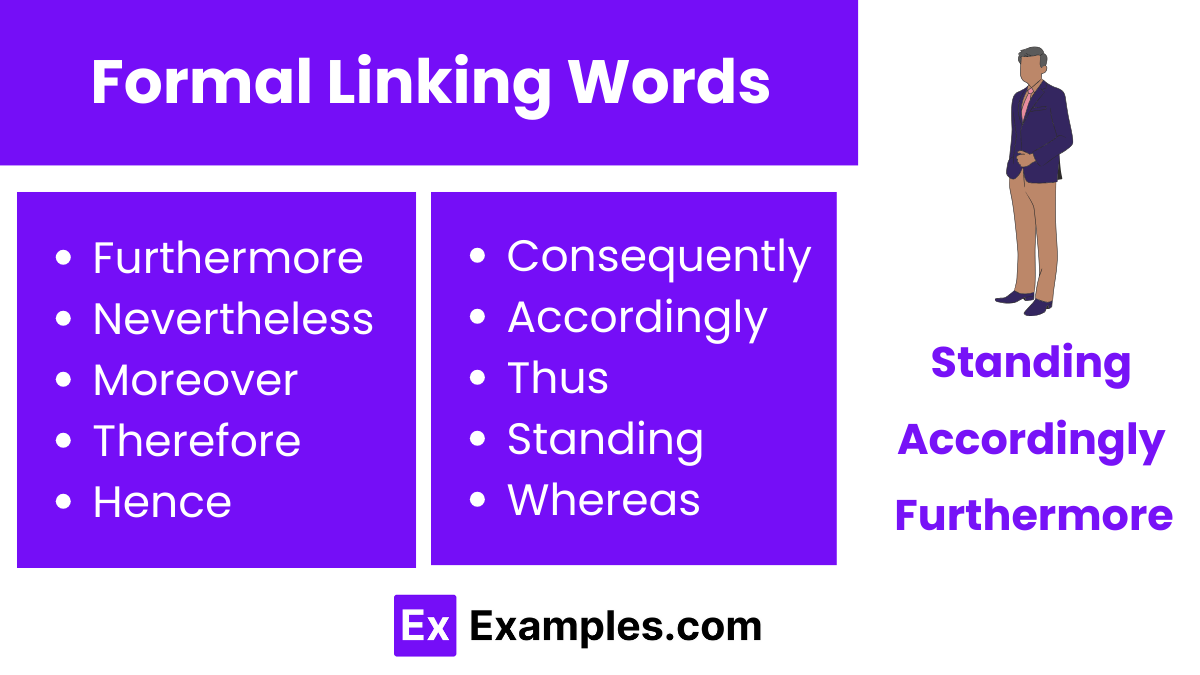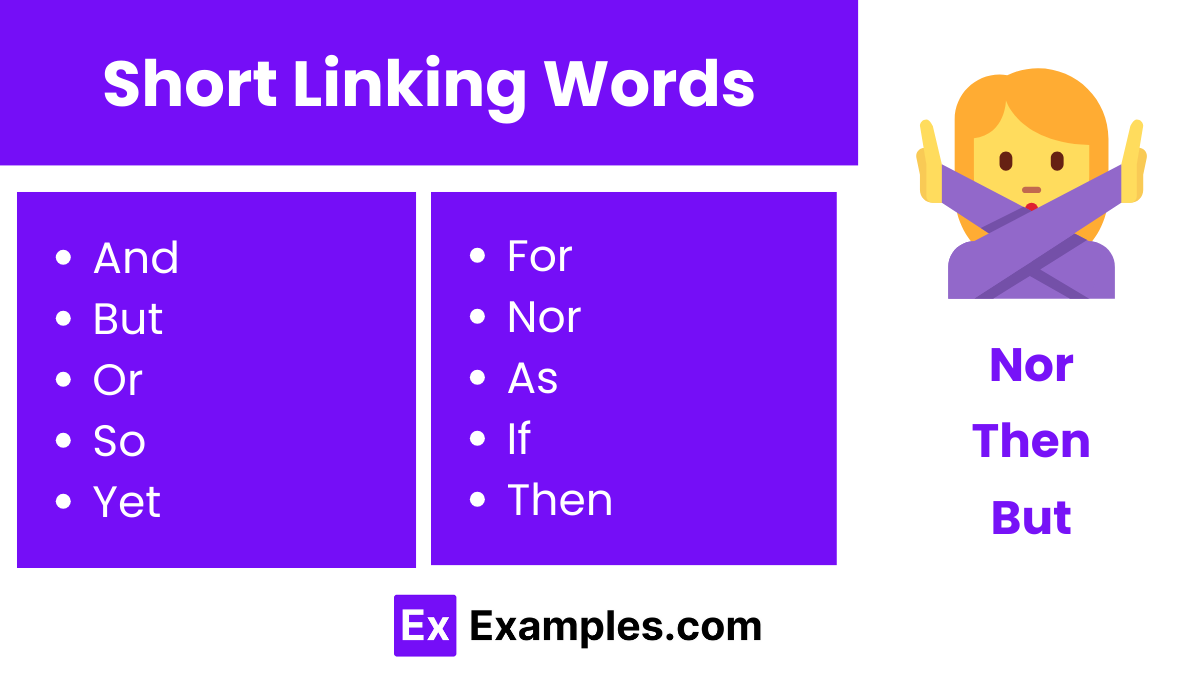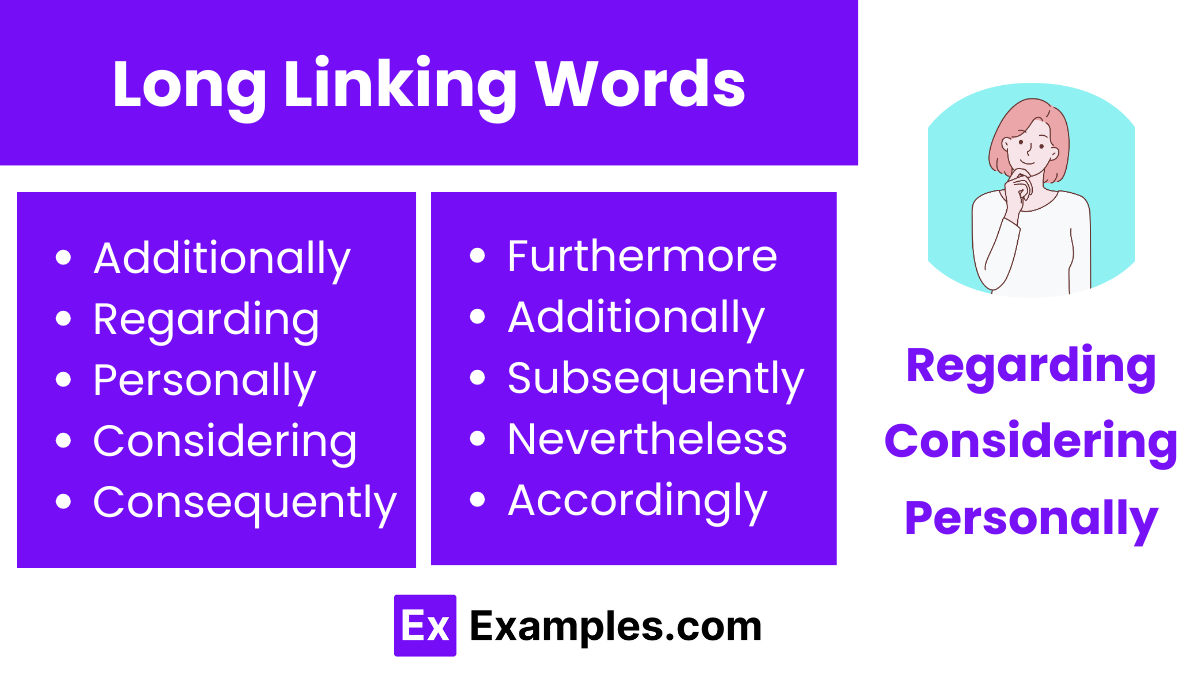450+ Linking Words List, Meaning, PDF
Linking words serve as bridges between thoughts, guiding readers through a sea of ideas with ease and clarity. These linguistic tools are essential for crafting coherent sentences and paragraphs, seamlessly connecting disparate ideas to weave a tapestry of thought that is both comprehensive and captivating. From essays to emails, understanding and utilizing linking words elevates your writing, ensuring your message is not just heard, but felt and understood. Explore the power of linking words and transform your communication into an art form.
Download Most Commonly used Linking Words - PDF
Most Commonly used Linking Words
| And | But | Or | So |
| Also | However | Nor | Therefore |
| Thus | Then | Hence | Besides |
| Consequently | Since | Until | While |
| Because | As | If | Unless |
| Whenever | After | Before | Once |
| Still | Indeed | Instead | Similarly |
| Furthermore | Namely | Specifically | Notably |
| Thirdly | Lastly | Equally | Next |
| Nonetheless | In contrast | In comparison | After all |
| In addition | By contrast | For instance | For example |
| Especially | Particularly | Including | Given that |
| As if | As well as | Apart from | Except for |
| Provided that | Supposing | Assuming that | In case |
| To illustrate | To demonstrate | To highlight | To emphasize |
| To conclude | To summarize | To sum up | In summary |
| To begin with | In the first place | At the same time | In the meantime |
| Eventually | Latterly | Currently | Formerly |
| Yet | In fact | For | On the other hand |
| Nevertheless | Such as | Moreover | Like |
| Otherwise | Considering that | Accordingly | As though |
| Although | Other than | Though | Beyond |
| Even though | In order to | Whereas | So that |
| As soon as | To clarify | As long as | To explain |
| Conversely | In conclusion | Additionally | To wrap up |
| Firstly | Subsequently | Secondly | Previously |
| Thereafter | Initially | Thereby | Lastly |
Linking Transition Words with Meanings
Linking transition words are pivotal in shaping clear and coherent communication, seamlessly connecting ideas and enhancing the readability of texts. These linguistic keys unlock the flow between sentences and paragraphs, making complex information easily digestible. Incorporating these words into your writing or speech not only elevates your language skills but also ensures your audience remains engaged and informed. Here are ten essential linking transition words, each bolded for emphasis, along with their meanings to aid in crafting compelling narratives.
- Moreover: Additionally, adds information that reinforces the point.
- However: Indicates a contrast to the previously mentioned idea.
- Therefore: Shows causation, implying a result or conclusion.
- Consequently: A result of the mentioned situation.
- Furthermore: Adds more information to support a point.
- Meanwhile: Indicates something happening at the same time as another activity.
- Indeed: Emphasizes a point or used as a confirmation.
- Thus: Indicates the conclusion of an argument or an inference.
- Nonetheless: Despite what has just been said or referred to.
- Similarly: Indicates that two points are alike in some way.
Types of Linking Words
Understanding the types of linking words enriches your writing, offering clarity and fluidity that captivates readers. These connectors are the glue that binds sentences and ideas together, facilitating a smoother transition and helping to convey complex thoughts in an organized manner. Whether you’re aiming to contrast, compare, conclude, or elaborate, the right type of linking word can dramatically improve the coherence of your narrative. Below is a list of ten types of linking words, highlighted in bold, crucial for versatile and dynamic communication.
- Addition: Introduces additional information or ideas.
- Contrast: Highlights differences between two or more ideas.
- Cause and Effect: Shows the reason something happens and its result.
- Sequence: Describes the order in which things happen.
- Comparison: Shows how two or more things are similar.
- Condition: Specifies conditions that affect the situation.
- Example: Provides an example to illustrate a point.
- Emphasis: Highlights the importance of something.
- Conclusion: Indicates the end of an argument or a summary of points.
- Time: Marks the timing of an event or action.
Formal Linking Words
Formal linking words are the hallmark of professional and academic writing, elevating the tone and style of communication. These words and phrases are pivotal in constructing arguments, elucidating points, and guiding readers through complex discussions with precision and authority. Employing formal linking words effectively can significantly enhance the persuasiveness and credibility of your writing, making it more compelling and respected in scholarly and professional arenas. Here are ten formal linking words, each bolded for emphasis, crucial for developing sophisticated and persuasive discourse.
- Furthermore: Adds additional information in support of a point.
- Nevertheless: Indicates a contrast or exception to what has been previously stated.
- Moreover: Introduces further information that adds to the argument.
- Therefore: Shows the result or conclusion of an argument.
- Hence: Indicates a conclusion drawn from the preceding information.
- Consequently: Describes a result or outcome of a given situation.
- Accordingly: Indicates an action or decision based on the mentioned reason.
- Thus: Summarizes or explains the result of an argument.
- Notwithstanding: Despite what has been mentioned before.
- Whereas: Shows a contrast between two different ideas or facts.
Informal Linking Words
Informal linking words bring a conversational and relatable tone to your writing, making it accessible and engaging for a wide audience. These words mimic natural speech, bridging thoughts in a way that feels spontaneous and genuine. Using informal connectors can make your text more lively and personable, perfect for blog posts, informal letters, and everyday dialogue. Here are ten informal linking words, presented in bold, that will add a touch of casual flair to your communications.
- Anyway: Moving from one topic to another; concluding a point.
- So: Explains the result or consequence of something.
- Like: Used for giving examples or making comparisons.
- Actually: Introduces a fact or an argument.
- Basically: Summarizes the most important aspect.
- Seriously: Emphasizes the sincerity or importance of a statement.
- Plus: Adds information in an informal manner.
- Well: Introduces a response, or a new topic, often used in conversation.
- Guess what: Used to introduce surprising or interesting information.
- By the way: Introduces a new topic of conversation tangentially related to the previous one.
Short Linking Words
Short linking words are the connective tissue of language, offering a quick and effective way to join ideas and clarify relationships between sentences and paragraphs. These compact connectors are essential for smooth transitions and maintaining the flow of thought, making them crucial for both spoken and written communication. Their simplicity and versatility facilitate clear, concise, and coherent narratives, suitable for a wide range of contexts. Below are ten short linking words, highlighted in bold, that are fundamental for crafting fluent and intelligible content.
- And: Connects similar ideas or adds information.
- But: Introduces a contrast or exception.
- Or: Presents alternatives or choices.
- So: Indicates a cause or effect relationship.
- Yet: Introduces a contrasting idea that follows logically.
- For: Explains the reason or purpose.
- Nor: Connects two negative alternatives.
- As: Introduces a comparison or reason.
- If: Specifies a condition.
- Then: Indicates the next step in a sequence.
Long Linking Words
Long linking words are indispensable tools in academic and professional writing, providing precise transitions and clarifying relationships between ideas. These phrases enhance the sophistication and clarity of communication, allowing writers to articulate complex relationships and nuanced thoughts effectively. They are particularly valuable in formal essays, reports, and presentations, where clear and structured expression is paramount. Here are ten long linking words, each bolded for emphasis, essential for constructing detailed and well-articulated arguments.
- Additionally: Expands on the current point with more detail.
- Regarding: Refers specifically to something mentioned.
- Personally: Expresses a personal opinion.
- Considering: Considers certain circumstances or evidence.
- Consequently: As a result of the described situation.
- Furthermore: In addition to what has been said.
- Additionally: Used to introduce more information.
- Subsequently: Following in time; coming after something else.
- Nevertheless: Regardless of what has previously been said.
- Accordingly: In a way that is appropriate to the particular circumstances.
Functions of Linking Words
This table categorizes and illustrates the use of linking words in English, Linking words, also known as transitional words or phrases, play a pivotal role in ensuring the coherence and flow of text by establishing clear connections between sentences and paragraphs. These linguistic tools are essential for guiding readers through the arguments and ideas being presented, acting as bridges that link disparate thoughts into a unified whole, which are instrumental in connecting ideas and ensuring the smooth flow of writing or speech. These words serve various functions, such as:
| Function | Linking Words | Example |
|---|---|---|
| Emphasis | indeed, in fact | “In fact, the study contradicts previous assumptions.” |
| Clarification | that is to say, in other words | “That is to say, the policy needs thorough revision.” |
| Concession | even though, albeit | “Even though the task was challenging, they succeeded.” |
| Dismissing | regardless, nevertheless | “Regardless of the risks, the explorer pressed on.” |
| Illustration | for instance, to illustrate | “To illustrate, let’s consider the case of climate change.” |
| Summarizing | in summary, to sum up | “To sum up, these factors significantly impact the results.” |
| Sequencing | subsequently, next | “Subsequently, the team analyzed the data.” |
| Highlighting | notably, particularly | “Notably, this theory was supported by recent findings.” |
| Consequence | thus, hence | “Hence, the project was not feasible under current conditions.” |
| Comparison | just as, similarly | “Just as the sun sets, so too does this era come to a close.” |
In summary, linking words are the essential threads that weave thoughts into coherent narratives, guiding readers through the tapestry of your ideas with precision and elegance. Their strategic use not only enhances clarity and flow but also enriches the reader’s understanding, making your writing more persuasive and engaging. Mastering these connectors is key to elevating your communication across all forms of discourse.



